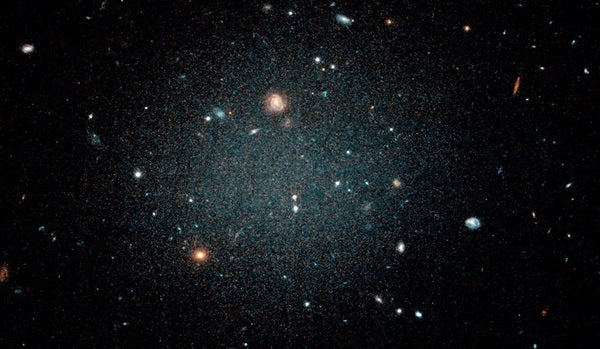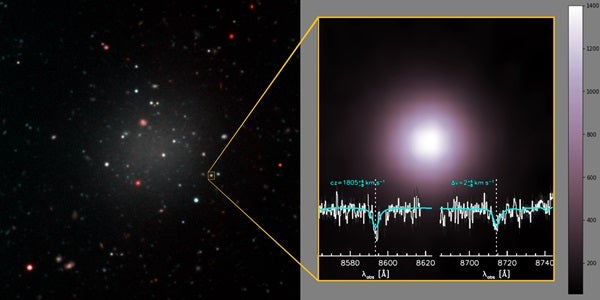“We thought that every galaxy had dark matter and that dark matter is how a galaxy begins,” said lead author Pieter van Dokkum, an astrophysicist at Yale University, in a press release. “This invisible, mysterious substance is the most dominant aspect of any galaxy. So finding a galaxy without it is unexpected. It challenges the standard ideas of how we think galaxies work, and it shows that dark matter is real: it has its own separate existence apart from other components of galaxies.”
The oddball galaxy in question, NGC1052-DF2 (or DF2 for short), is a small galaxy in a collection of galaxies dominated by the much larger elliptical NGC 1052. The relatively innocuous galaxy DF2 only stood out to the researchers when they noticed it appeared differently in images taken by the Dragonfly Telephoto Array and those taken by the Sloan Digital Sky Survey (SDSS). In the Dragonfly images, DF2 looked like a blob of dim and diffuse light, but in the SDSS images, it appeared as a group of point-like sources.
To investigate, the team observed DF2 using the Advanced Camera for Surveys on the Hubble Space Telescope (HST) and performed follow-up spectroscopic observations with the 10-meter W.M. Keck Observatory. “I spent an hour just staring at the Hubble image,” said van Dokkum. “It’s so rare, particularly these days after so many years of Hubble, that you get an image of something and you say, ‘I’ve never seen that before.’ This thing is astonishing: a gigantic blob that you can look through. It’s so sparse that you see all of the galaxies behind it. It is literally a see-through galaxy.” Using the Hubble data, the researchers were able to determine that DF2, which they consider an ultra-diffuse galaxy due to its large size and transparent appearance, is located about 65 million light-years away. Although the galaxy is about as large as the Milky Way, they found it contains 200 times fewer stars.
Based on the spectroscopic data the team collected with Keck, they identified 10 globular clusters – large, spherical groups of typically old stars – on the outskirts of DF2. Surprisingly, they found that all of these globular clusters were rotating around DF2 three times more slowly than they would be if the galaxy contained a typical amount of dark matter in addition to its sparse amount of normal matter. The researchers then calculated the galaxy’s overall mass and found that, “if there is any dark matter at all, it’s very little,” said van Dokkum. “The stars in the galaxy can account for all the mass, and there doesn’t seem to be any room for dark matter.”
However, as is usually the case, the researchers have a few ideas about how the galaxy initially formed. One possible scenario they lay out in the paper is that DF2 is actually a tidal dwarf galaxy. This type of galaxy can form during galactic mergers, which often fling out baryonic material – ordinary matter that is made up of protons, neutrons, and electrons. However, DF2 appears to have fewer metals than would be expected for a tidal dwarf galaxy. Another option is that the galaxy formed when winds from a nearby quasar swept up large clouds of low-metallicity gas, but the researchers point out that the galaxy may be too diffuse for this to be a likely scenario. Finally, the researchers suggest DF2 may have formed when portions of gas flowing toward NGC 1052 broke away due to jet-induced shocks from the larger galaxy’s black hole.
No matter how DF2 formed, the team’s findings demonstrate that dark matter is indeed a physical building block that can be separated from baryonic matter, and, as a result, the findings also cast doubt on some alternative theories to dark matter. One such theory is known as modified Newtonian dynamics (MOND), which aims to eliminate the need for dark matter by proposing that the gravitational force acts differently on low-acceleration objects, such as those found on the outer fringes of galaxies.
“This result poses a very strong challenge to MOND,” explained Yotam Cohen, an astronomy graduate student at Yale and co-author of the study, on the news-sharing site Reddit. “In MOND, the extra gravitational forces observed on galactic scales are woven into the equations, meaning that wherever you see galaxies, you should see the effect of the modified gravity. However, in this galaxy, there is no need for the extra gravity to explain its kinematics. In other words, this suggests that galaxies and dark matter are separable components and, by extension, that dark matter is a material substance, which is the opinion of the majority of professional astronomers.”
But before astronomers can make any sweeping conclusions about the true nature of our universe, the study’s extraordinary findings must first be verified and replicated. At this point, the team is already busy analyzing more Hubble images of dim and diffuse galaxies similar to DF2. “We currently have a sample of about 20 other low-surface-brightness galaxies identified with Dragonfly and subsequently followed up with HST imaging,” Cohen told Astronomy via email. “Among these objects, there are a few that have similar brightness and structure to NGC1052-DF2, but none quite as spectacular and none with quite as many star cluster candidates.”
Though there have been several recent challenges to our current understanding of dark matter — such as the finding that satellite galaxies move together in an orderly fashion instead of randomly, as dark-matter models predict — this is not necessarily a bad thing. Instead, it simply means that our current understanding of dark matter is not entirely correct. This should not be a complete surprise considering we have yet to detect direct evidence of the elusive material. Confusing results force scientists to look at a problem in different ways, which typically leads them to revise and update their theories so they better describe reality.
After all, to paraphrase Isaac Asimov, the most exciting phrase to hear in science is not ‘Eureka,’ but rather, ‘hmm… that’s odd.’











